

Technology Driven Classrooms (TDC) Technology in the Classroom: Digital Media. A New Understanding of the Digital Divide. As an urban teacher whose students are often lacking access to a computer and the Internet at home, I have strong opinions and experiences with the digital divide.
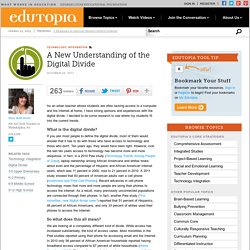
I decided to do some research to see where my students fit into the current trends. What is the digital divide? If you ask most people to define the digital divide, most of them would answer that it has to do with those who have access to technology and those who don't. Ten years ago, they would have been right. About - Understanding Educational Technology. Teaching with the Internet: Lessons from the Classroom., 1999. This book shows teachers how to effectively integrate the Internet into the classroom, and illustrates how teachers are developing classroom communities filled with the excitement of learning and discovery.
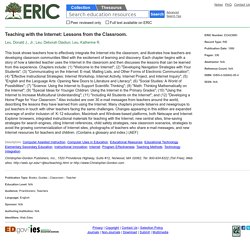
Each chapter begins with a story of how a talented teacher uses the Internet in the classroom and then discusses the lessons that can be learned from this experience. Emotional Engagement in Education, Part Two: Motivate Students with Class Action. This is the second post in a three-part entry.

Read part one and part three. How do you respond in your classroom to a societal, medical, or environmental concern? Here's the next step in planning how to use such a problem as a springboard for a class project. Digital Life 101 (6-8) Is School Enough? Exploring Interest-Driven and Informal Learning. Is School Enough?
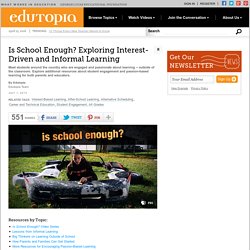
Video Series Edutopia's new video series profiles young people who are pursuing their passions and making their learning more authentic by taking it into their own hands, on their own time. This series is produced by Mobile Digital Arts and Twin Cities Public Television, as a companion to an hour-long PBS special that is now available to watch. What Is Successful Technology Integration?
Technology integration is the use of technology resources -- computers, mobile devices like smartphones and tablets, digital cameras, social media platforms and networks, software applications, the Internet, etc. -- in daily classroom practices, and in the management of a school. Successful technology integration is achieved when the use of technology is: Routine and transparent Accessible and readily available for the task at hand Supporting the curricular goals, and helping the students to effectively reach their goals When technology integration is at its best, a child or a teacher doesn't stop to think that he or she is using a technology tool -- it is second nature. And students are often more actively engaged in projects when technology tools are a seamless part of the learning process.
Defining Technology Integration Willingness to embrace change is also a major requirement for successful technology integration. Learning Inside an Out-of-School Newsroom. Editor's Note: Our guest blogger this week is Elisabeth (Lissa) Soep, PhD, research director and senior producer at Youth Radio, a Peabody Award-winning, youth-driven production company in Oakland, California, with bureaus across the country and partners around the world.
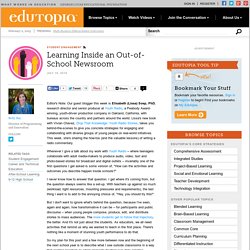
Lissa's new book with Vivian Chavez, Drop That Knowledge: Youth Radio Stories, takes you behind-the-scenes to give you concrete strategies for engaging and collaborating with diverse groups of young people on real-world initiatives. This week, she's sharing the how-tos (and the valuable lessons) of writing a radio commentary. Whenever I give a talk about my work with Youth Radio -- where teenagers collaborate with adult media-makers to produce audio, video, text and photo-based stories for broadcast and digital outlets -- invariably one of the first questions I get asked is some version of, "How can the activities and outcomes you describe happen inside schools? " I never know how to answer that question. The Flipped Mobile Classroom: Learning "Upside Down" In the past few months, the flipped-learning model has hit mainstream media with articles appearing in the New York Times and even Southwest Airlines' Spirit magazine.

Traditionally, students learn new information through lecture or direct instruction while in school. Social Networking Fact Sheet. Highlights of the Pew Internet Project’s research related to social networking.
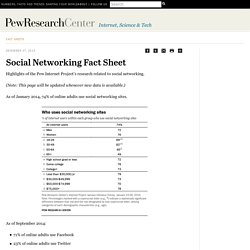
(Note: This page will be updated whenever new data is available.) As of January 2014, 74% of online adults use social networking sites. As of September 2014: Technology Accommodations. An accommodation is a change in how an assessment or instruction is given, but does not indicate a change in what is being measured or a change in the material.
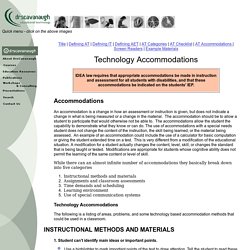
The accommodation should be to allow a student to participate that would otherwise not be able to. The accommodations allow the student the capability to demonstrate what they know or can do. The use of accommodations with a special needs student does not change the content of the instruction, the skill being learned, or the material being assessed. An example of an accommodation could include the use of a calculator for basic computation or giving the student extended time on a test. Laptop Programs for Students. National Education Technology Plan. The National Education Technology Plan is the flagship educational technology policy document for the United States. The Plan articulates a vision of equity, active use, and collaborative leadership to make everywhere, all-the-time learning possible.
While acknowledging the continuing need to provide greater equity of access to technology itself, the plan goes further to call upon all involved in American education to ensure equity of access to transformational learning experiences enabled by technology. The principles and examples provided in this document align to the Activities to Support the Effective Use of Technology (Title IV A) of Every Student Succeeds Act as authorized by Congress in December 2015. In order to keep pace with the changes we are seeing in schools, districts, and states on an almost daily basis, we are updating the NETP more often.
Feedback from our stakeholders indicates that the previous five year update cycle was not frequent enough. What Forty Years of Research Says About the Impact of Technology on Learning. Welcome to the Egan Library proxy server! Technology Integration Research Review: Evidence-Based Programs by Subject. In the following sections, we review specific technology integration practices that have been shown to enhance teaching and learning in four academic subject areas: You may also skip to the section on Additional Evidence-Based Programs for Learning for more on tech for collaborative discussion, assessment, customizing instruction, and teaching digital literacy.
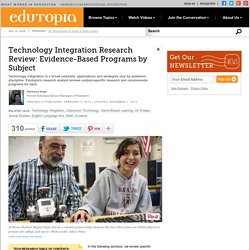
Technology for Learning Reading According to a meta-analysis of reading technology models, including 84 rigorous studies and over 60,000 K-12 participants, the largest impacts on K-12 reading achievement come from comprehensive models that integrate computer and non-computer instruction in the classroom and provide extensive support for teachers' professional development (Cheung and Slavin, 2012).
Such comprehensive models include READ 180, Writing to Read, and Voyager Passport. Girls and Robotics. Editor's Note: In this blog sponsored by Lego, author Mary Beth Hertz mentions her use of the Lego Mindstorm product.

Hertz did not know Lego was sponsoring her blog and Lego made no request for product mentions. To best serve our audience, Edutopia is leaving the reference intact, as it reflects the facts of the author's experience and not any commercial arrangement between Lego and Edutopia. Right now in education, it seems like everyone is talking about STEM (Science, Technology, Engineering and Math). Once again, our government has had a knee-jerk reaction to the success that other countries are having on international science and math tests. Technology Integration Research Review. Editor's Note: This article was originally written by Vanessa Vega, with subsequent updates made by the Edutopia staff.
Technology integration can be one of the most challenging topics to find quality research on. The term itself is a broad umbrella for numerous practices that may have little in common with each other. In addition, technology tools change rapidly, and outcomes can vary depending on implementation. Edutopia's tech integration review explores some of the vast body of research out there and helps you navigate useful results. Challenge Winners - Gallery - Mindstorms LEGO.com. Did you know that 2014 is the Year of the Maker? The LEGO MINDSTORMS team was at World Maker Fair in New York City this past September for the first time! We shared and saw a lot of amazing robots including one tagged as an honorable mention in this contest (can you guess which one?). Speaking of this building challenge, to honor of Maker Fair and the Year of the Maker, the MINDSTORMS team challenged the community to show off their inner ROBOT MAK3R.
AJET 19(1) Herrington, Oliver and Reeves (2003) - engagement in authentic online learning environments. Jan Herrington, Ron OliverEdith Cowan UniversityThomas C. ReevesThe University of Georgia, USA The use of authentic activities within online learning environments has been shown to have many benefits for learners in online units and courses. There has been renewed interest in the role of student activities within course units, as constructivist philosophy and advances in technology impact on educational design and practice.
Courses based on these principles have been used successfully across a wide variety of discipline areas. Blended learning: Uncovering its transformative potential in higher education. Welcome to the Egan Library proxy server! Age of Distraction: Why It’s Crucial for Students to Learn to Focus. Digital classroom tools like computers, tablets and smartphones offer exciting opportunities to deepen learning through creativity, collaboration and connection, but those very devices can also be distracting to students. What Can Video Games Teach Us about Teaching Reading?: OneSearch. Welcome to the Egan Library proxy server!
Providing technology leadership for restructured schools: OneSearch. Using Smart Boards and Manipulatives in the Elementary Science Classroom: EBSCOhost. Flipped-Learning Toolkit: Let's Talk Tech. Editor's Note:This post was co-authored by Aaron Sams, Managing Director of FlippedClass.com and founding member of the Flipped Learning Network. Welcome to the Egan Library proxy server! Welcome to the Egan Library proxy server! The Digital Divide in Classroom Technology Use: A Comparison of Three Schools. The Digital Divide in Classroom Technology Use: A Comparison of Three Schools.
Measuring Student Attitude and Knowledge in Technology-Rich Biology Classrooms. Digital Storytelling and its Practical Usages as a Dissemination Tool. Parents' Perceptions of Communication Patterns and Effectiveness of Use of Augmentative and Alternative Communication Systems by Their Children With Angelman Syndrome. What Do We Do with These Computers? Reflections on Technology in the Classroom - Journal of Research on Technology in Education - Volume 35, Issue 1. How and Why Educators Use Twitter: A Survey of the Field - Journal of Research on Technology in Education - Volume 46, Issue 4. Providing technology leadership for restructured schools: EBSCOhost. Examining Teachers’ Beliefs About the Role of Technology in the Elementary Classroom - Journal of Research on Computing in Education - Volume 32, Issue 1.